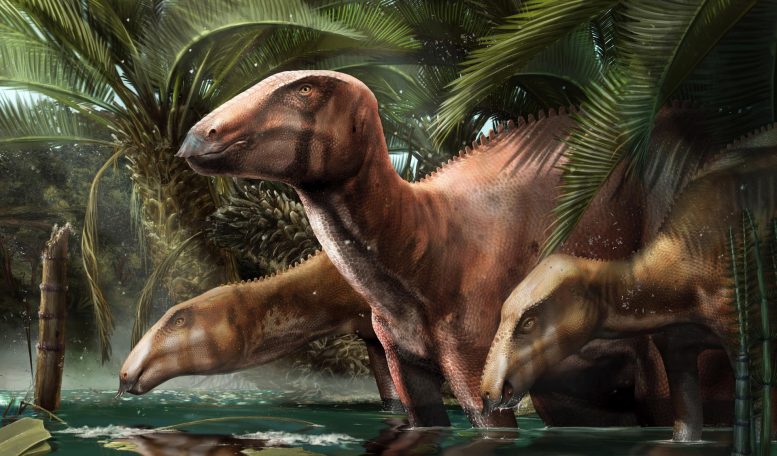
An adult and two juvenile individuals of the dinosaur Tethyshadros insularis showing the different appearances exhibited by immature and mature specimens in the ancient environment of Villaggio del Pescatore, the first locality in Italy preserving many dinosaur individuals of the same species. Credit: Davide Bonadonna
A dinosaur trove in Italy rewrites the history, geography, and evolution of the ancient Mediterranean area.
Italy is not exactly renowned for dinosaurs. In comparison to its excellent artistic and archaeological heritage, dinosaur fossils are very rare. Not surprisingly, the discovery of the first isolated remains from these animals, in the early 1990s, generated quite an excitement, but were shortly after considered nothing more than an exception to a general rule. During the reign of dinosaurs, between 230 and 66 million years ago, the ancient Mediterranean area would have been hard to map, formed by countless small islands far from all major mainlands – Europe, Africa, and Asia – unsuitable to sustain large animals like the dinosaurs. Or so we believed.
Now, a new study published on Scientific Reports and coordinated by researchers from the University of Bologna unveils the first palaeontological site with multiple, exceptionally complete dinosaur skeletons from Italy: the Villaggio del Pescatore site, located in the Duino-Aurisina municipality, near Trieste, in north-eastern Italy.
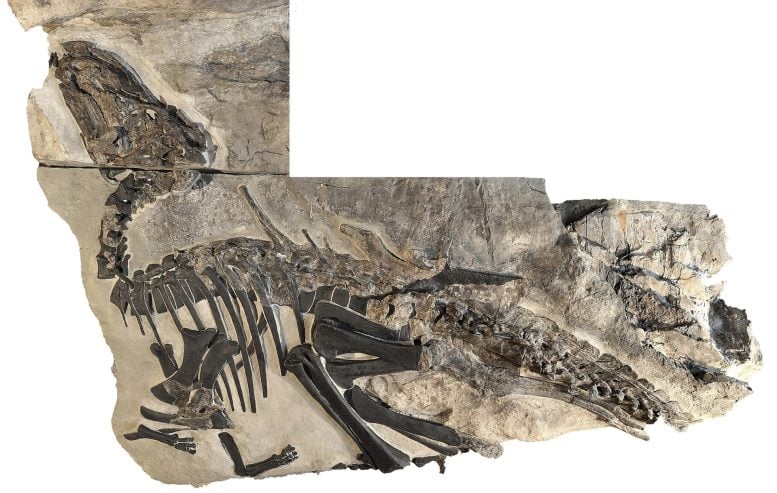
The skeleton of Bruno, an adult individual of the dinosaur Tethyshadros insularis described in this new study. Credit: P. Ferrieri (courtesy of Soprintendenza Archeologia, belle arti e paesaggio del Friuli-Venezia Giulia)
These beautiful skeletons belong to the species Tethyshadros insularis and represent the biggest and most complete dinosaur ever found in this Country. The team describes the skeletons of some of the most beautiful and pristine dinosaurs from the site (in particular of a new individual nicknamed “Bruno”) and highlights the occurrence of seven (probably eleven) individuals at the Villaggio del Pescatore.
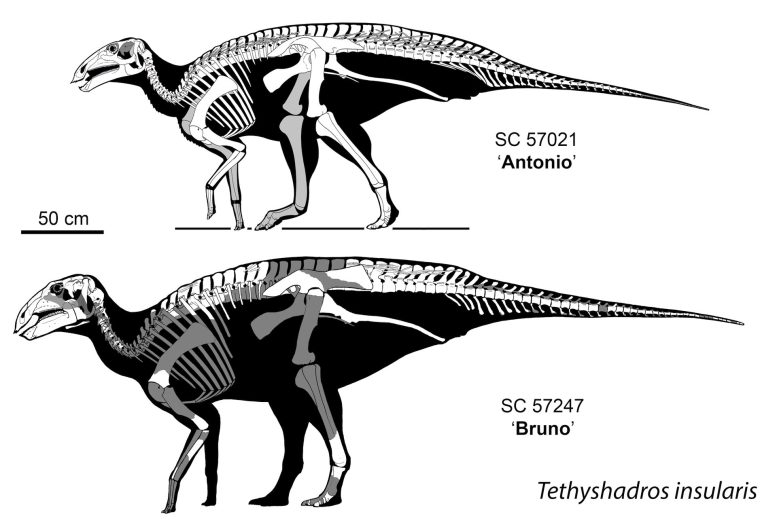
Skeletal reconstructions of the two individuals of Tethyshadros insularis, with the immature specimen nicknamed “Antonio” (above) and the mature, newly described skeleton of “Bruno” below. Credit: University of Bologna
Dinosaurs are not the only fossil remains from the site: fish, crocodiles, flying reptiles and even small crustaceans provide a vivid picture of an ancient ecosystem that has no equal worldwide. The unique fossils collected from the Villaggio del Pescatore can be admired in Trieste at the Museo Civico di Storia Naturale, granted on deposit by the Italian Ministry of Culture.
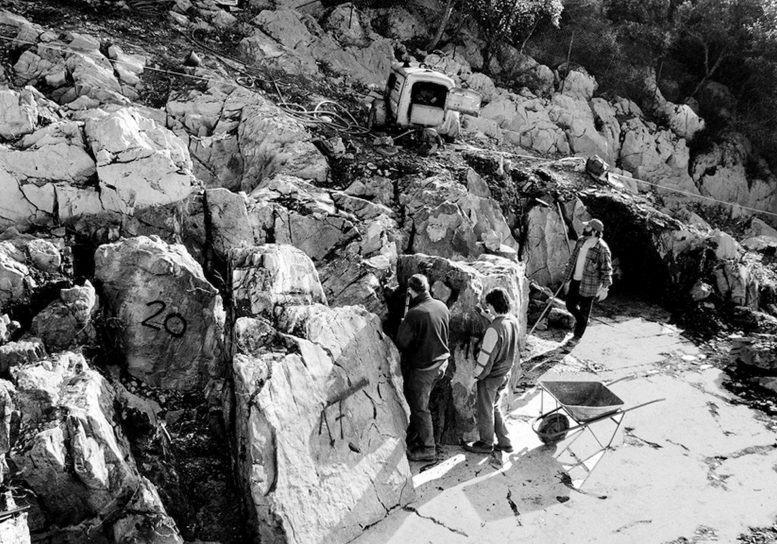
The palaeontological site of Villaggio del Pescatore, with people from ZOIC working to extract the fossils from this astounding dinosaur trove. Credit: ZOIC s.r.l.
The study also reviews and rewrites many evolutionary hypotheses to interpret the ancient Mediterranean context. Originally, geologists interpreted the area that today is the Villaggio del Pescatore site as part of an island in the middle of a “proto-Mediterranean” ocean called Tethys. This supported the incorrect interpretation that the relatively small, first dinosaur skeleton found at the site (nicknamed “Antonio”), was actually a “dwarf” species, an example of the so-called “island rule” (the evolutionary miniaturization of bigger animals in an insular environment due to the scarcity of resources).
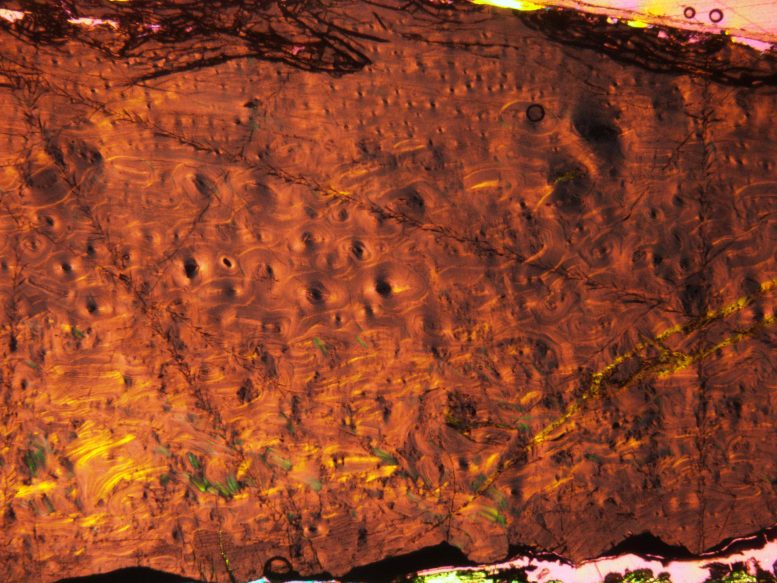
The bones of “Antonio” under the microscope, showing the bone cells (black, circled dots): the fossilized bone tissues were analyzed to infer the relative age of the dinosaur skeletons at the time of their death. Credit: University of Bologna
In this new study, the research team documents that “Antonio” is an immature individual, whereas “Bruno,” which is bigger in size, represents an older individual – and that could have been still growing at the time of its death.
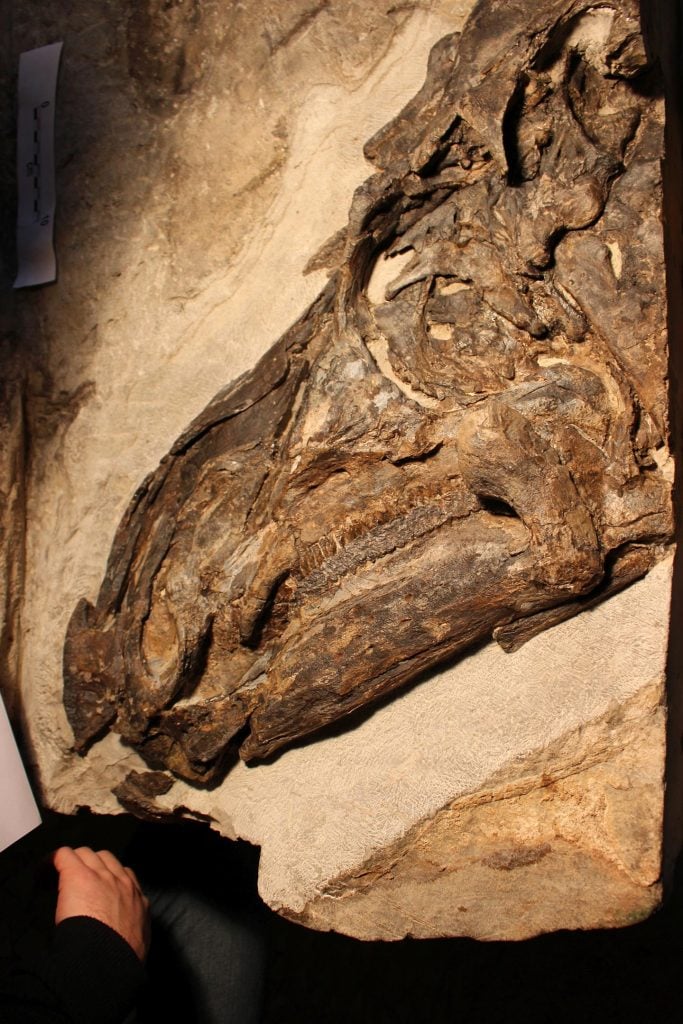
The skull of “Bruno,” the newly described skeleton of the dinosaur Tethyshadros insularis. Credit: A. Giamborino (courtesy of Soprintendenza Archeologia, belle arti e paesaggio del Friuli-Venezia Giulia)
New geological data gathered by the team also provided the age of the site and its fossils: approximately 80 million years ago, in the Cretaceous period. This is about 10 million years older than previously thought: quite a long time even when dealing with dinosaurs. At that time, what is now north-eastern Italy was a land facing a vast ocean but connected to western Europe and Asia. This means that not only small islands characterized the ancient Mediterranean, but many migratory routes for large terrestrial animals like the dinosaurs might have been possible across land bridges of what we nowadays call Italy.
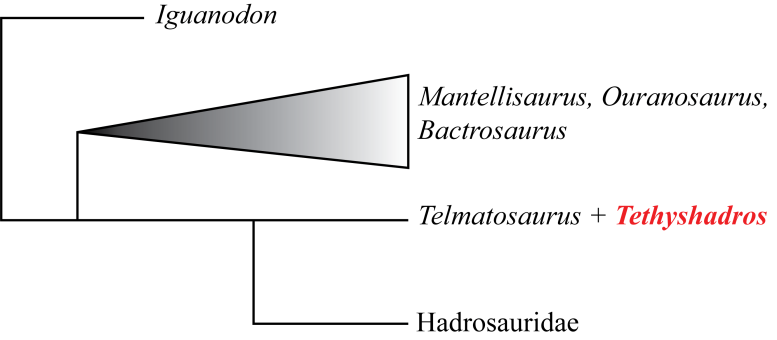
A simplified evolutionary tree showing where Tethyshadros would fit between its hadrosauriform relatives, the so-called duck-bill dinosaurs. Credit: University of Bologna
This new research highlights not just a first in terms of exceptional findings, but most importantly the pivotal role of the Italian dinosaur fossil record for evaluating important scientific hypotheses on these ancient animals. As the site is already protected from the Italian institutions, new research and didactic activities may represent an opportunity to include the geological and paleontological heritage in the “must-see” list while visiting the “Belpaese.”
Reference: “An Italian dinosaur Lagerstätte reveals the tempo and mode of hadrosauriform body size evolution” by Alfio Alessandro Chiarenza, Matteo Fabbri, Lorenzo Consorti, Marco Muscioni, David C. Evans, Juan L. Cantalapiedra and Federico Fanti, 2 December 2021, Scientific Reports.
DOI: 10.1038/s41598-021-02490-x
The researchers involved in the study are: Alfio Alessandro Chiarenza (University of Vigo), Matteo Fabbri (Field Museum of Natural History, Chicago), Lorenzo Consorti (University of Trieste and Geological Survey of Italy – ISPRA), Juan Cantalapiedra (Universidad de Alcalá), David Evans (Royal Ontario Museum and University of Toronto), Federico Fanti and Marco Muscioni (University of Bologna).



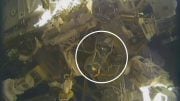

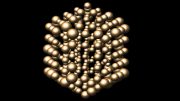



Babu G. Ranganathan*
(B.A. Bible/Biology)
THE NATURAL LIMITS TO EVOLUTION
ONLY LIMITED EVOLUTION (micro-evolution or evolution within biological “kinds”) is genetically possible (such as the varieties of dogs, cats, horses, cows, etc.), but not macro-evolution, or evolution across biological “kinds,” (such as from sea sponge to human). All real evolution in nature is simply the expression, over time, of already existing genes or variations of already existing genes. For example, we have breeds of dogs today that we didn’t have a few hundred years ago. The genes for these breeds had always existed in the dog population but never had opportunity before to be expressed. Only limited evolution, variations of already existing genes and traits, is possible.
The genes (chemical instructions or code) for a trait must first exist or otherwise the trait cannot come into existence. Genes instruct the body to build our tissues and organs. Nature is mindless and has no ability to design and program entirely new genes for entirely new traits.
Evolutionists believe that, if given millions of years, accidents in the genetic code of species caused by the environment will generate entirely new code making evolution possible from one type of life to another. It’s much like believing that by randomly changing the sequence of letters in a romance novel, over millions of years, can turn the novel into a book on astronomy! Not to worry. We’ll address the issue of “Junk DNA” in a moment.
WHAT ABOUT NATURAL SELECTION? Natural selection doesn’t produce biological traits or variations. It can only “select” from biological variations that are possible and which have survival value.
HOW COULD SPECIES HAVE SURVIVED if their vital tissues, organs, reproductive systems, etc. were still evolving? A partially evolved trait or organ that is not complete and fully integrated and functioning from the start would be a liability to a species, not a survival asset. Plants and animals in the process of macro-evolution would be unfit for survival. For example, “if a leg of a reptile were to evolve (over supposedly millions of years) into a wing of a bird, it would become a bad leg long before it became a good wing” (Dr. Walt Brown, scientist and creationist). Survival of the fittest actually would have prevented evolution across biological kinds!
NEW SPECIES BUT NOT NEW DNA: Although it’s been observed that new species have come into existence, they don’t carry any new genes. They’ve become new species only because they can’t be crossed back with the original parent stock for various biological reasons. A biological “kind” allows for new species but not new genes. Nature has no ability to invent new genes for new traits. Only limited variations and adaptations are possible in nature, and all strictly within a biological “kind” (i.e. varieties of dogs, cats, etc.).
Dr. Randy J. Guliuzza’s extensive research points to a better explanation than natural selection for variation and adaptation in nature. Dr. Guliuzza explains that species have pre-engineered mechanisms that enable organisms to continuously track and respond to environmental changes with system elements that correspond to human-designed tracking systems. This model is called CET (continuous environmental tracking). His research strongly indicates that living things have been pre-engineered to produce the right adaptations and changes required to live in changing environments. It’s much like a car that’s been pre-engineered so that the head lights turn on automatically when day changes to night.
What about genetic and biological similarities between species? Genetic information, like other forms of information, cannot happen by chance, so it is more logical to believe that genetic and biological similarities between all forms of life are due to a common Designer who designed similar functions for similar purposes. It doesn’t mean all forms of life are biologically related! Only genetic similarities within a natural species proves relationship because it’s only within a natural species that members can interbreed and reproduce.
Many people have wrong ideas of how evolution is supposed to work. Physical traits and characteristics are determined and passed on by genes – not by what happens to our body parts. For example, if a woman were to lose her finger this wouldn’t affect how many fingers her baby will have. Changing the color and texture of your hair will not affect the color and texture of your children’s hair. So, even if an ape or ape-like creature’s muscles and bones changed so that it could walk upright it still would not be able to pass on this trait to its offspring. Only changes or mutations that occur in the genetic code of reproductive cells (i.e. sperm and egg) can be passed on to offspring.
What about the new science of epigenetics? Epigenetics involves inheritable factors which can turn already-existing genes on, but epigenetics doesn’t create new genes.
Most biological variations are from new combinations of already existing genes, not mutations. Mutations are accidents in the genetic code caused by nature (i.e. environmental radiation), are mostly harmful, and have no capability of producing greater complexity in the code. Even if a good accident occurred, for every good one there would be hundreds of harmful ones with the net result, over time, being harmful, even lethal, to the species. Even if a single mutation is not immediately harmful, the accumulation of mutations over time will be harmful to the species resulting in extinction. At very best, mutations only produce further variations within a natural species.
All species of plants and animals in the fossil record are found complete, fully formed, and fully functional. This is powerful evidence that all species came into existence as complete and fully formed from the beginning. This is only possible by creation.
God began with a perfect and harmonious creation. Even all the animals were vegetarian (Genesis 1:30) in the beginning and did not struggle for survival nor kill and devour each other. Macro-evolutionary theory does not begin with a perfect and harmonious creation as the Bible states. The Bible and macro-evolutionary theory cannot both be true.
All the fossils that have been used to support human evolution have been found to be either hoaxes, non-human, or human, but not non-human and human (i.e. Neanderthal Man was discovered later to be fully human).
There has never been unanimous agreement among evolutionary scientists on ANY fossil evidence that has been used to support human evolution over the many years, Including LUCY.
The actual similarity between ape and human DNA is between 70-87% not 99.8% as commonly believed. The original research stating 99.8% similarity was based on ignoring contradicting evidence. Only a certain segment of DNA between apes and humans was compared, not the entire DNA genome.
Also, so-called “Junk DNA” isn’t junk. Although these “non-coding” segments of DNA don’t code for proteins, they have recently been found to be vital in regulating gene expression (i.e. when, where, and how genes are expressed, so they’re not “junk”). Also, there is evidence that, in certain situations, they can code for protein.
ARE FOSSILS REALLY MILLIONS OF YEARS OLD? (Internet article by author)
Visit my latest Internet site: THE SCIENCE SUPPORTING CREATION (This site answers many arguments, both old and new, that have been used by evolutionists to support their theory)
Author of popular Internet article, TRADITIONAL DOCTRINE OF HELL EVOLVED FROM GREEK ROOTS
*I have given successful lectures (with question and answer period afterwards) defending creation before evolutionist science faculty and students at various colleges and universities. I’ve been privileged to be recognized in the 24th edition of Marquis “Who’s Who in The East” for my writings on religion and science.
Babu, Bible?? Evolution is very clearly shown in the layered rocks of the Grand Canyon which begin with the primitive small microbe fossil at the bottom and transition to the top with increasingly complex invertebrate fossils. All with no reversals nor mixed in bones from any dinosaurs or other vertebrates. How could that have been possible without some biological evolution taking place?
There seemed to be a small mistake in the artice? “As the site is already protected from the Italian institutions,”
Not “from” but “by”?
Ken – Babu is exactly correct. You have to look at the ecology of the what the earth was and still is 10-5K years ago. Where do you find the most “primitive small microbe fossils?” In the oceans, of course. So what would be the first thing to be fossilized during the flood? Whatever was swept away on the bottom of or contained in the ocean. The problem with your statement is that you do not factor is that there are significant amounts of polystratic fossils in the Grand Canyon and across the world. Just google, Polystrate Fossils in the Grand Canyon and it will pull up a plethora of finds, just in the Grand Canyon. There are multiple petrified trees stretching across multiple strata. How does that happen over millions of years?????
https://answersingenesis.org/geology/grand-canyon-facts/fossil-evidence-grand-canyon/
Mr. Babu you are not versed enough in chemical evolution you need to read my book on “Emergent Chemical Evolution” available on Amazon to learn how unique information evolves and new genes are formed!!
Badit scientist is over they found dinosaur allready spinosauridae is fully formed mesoeucrocodylia they are first thecodont with a death roll system .thecodont mean crocodilian teeth animal ,gator is a new world crocodilian.clearly design to kill bigger prey with the same jaw as the gator and neck probaly ribs .reign of dinosaur is not over Nile crocodile number are still high it could be higher but it’s because of human .modern crocodilian is greatest dinosaur ever they have deevolution ziphodont teeth happen many time in mesoeucrocodylia. The advance eusuchian mesoeucrocodylia black caiman broad snout caiman lack archosaur feature it’s not like there primitive ancestor Nile crocodile .modern crocodilian clearly superior to dinosaur better bipedal they can sprawl and bipedal and a human ankle .predator dinosaur only could bipedal there quadrupedal was a joke it’s crouch launch but they did get a furcula out of it .gator quadrupedal hate furcula like all quadrupedal animal .gator can smell better and hear better .spinosauridae a early mesoeucrocodylia the top dinosaur is no more just like early gator type mesoeucrocodylia and early eusuchian .3 toe claw tyrannosaur is king of dinosaur and alive .badit scientist evidence is a joke it team up with corrupt media and hope that creationist does go to the right school .were is bandit scientist on the internet more bandit media.250 million years ago dinosaur to 200 million dinosaur was doing very good but these were gator ankle dinosaur.pterosaur is a dinosaur clearly came from a bipedal land dinosaur it could not fly it was vey aquatic a sting ray mimic.cat and spinosauridae can do the falling from the building trick and land on there feet a motor back feature death roll feature long animal feature.
Writing in English? Please learn how.
Understand argument but that was just painful. Like Creationists who try to butcher science (Science!) by posting long, drawn out arguments that have no basis in scientific fact.
All my evidence is fact I can read I was educated on the internet by scientist report .all my links are true and read by scientist and amature like me they saw it. I am well known on the internet even was help by badit scientist.i am shore I did not give gator fully second bony palate so he can breathe while eating a technology found in mammal t.rex and spinosaurus and gator.so that the gator over the top bite force make him king of the dinosaur the last of the spinosauridae the very improve spinosauridae .t.rex secondary bony palate is short not full air goes trough like the turtle mammal type reptile it all most is close in these reptile turtle mammal type reptile. the palate must be seal to be a full palate no air should go trough some scientist say mesoeucrocodylia is unique in thecodont by haveing a large secondary bony palate but not useing the word full because it easyer to tell gator and spinosauridae are the same animal and easyer to trace them to tyrannosaur because they only reptile with a full palate that why palate science want you to say full because some reptile palate bigger than other but they are not full .and it will prove gator was allways was advance .palate science allso want you to say bony palate .human a mammal has two palate one bony the other fleshy the second palate is fleshy a primitive palate it can change to bone in the future maybe million years or more.human a mammal has a full palate like all mammal .gator has two roof in his mouth two bony palate that why it has over the top bite force that can crush metal the bigger the palate stronger the bite force modern crocodilian have a giant skull .spinosauridae gharial false gharial have biggest skull in mesoeucrocodylia .eusuchian mesoeucrocodylia like the gator have a bigger palate it’s fuse to the braincase they have stronger skull than early mesoeucrocodylia like spinosauridae gator type early mesoeucrocodylia .the problem with spinosauridae skull it only strong big they would have problem with a small snout or thinner skull they do not have the back up like gator type early mesoeucrocodylia or eusuchian like 6 bone fuse to braincase they have primitive reptile feature of 2 .gator and mammal have 6 and gator palate fuse to braincase .that why gator type early mesoeucrocodylia have so many skull shape smaller skull is better on land or thinner skull for aquatic the gharial it lost big predator feature in his skull but still could kill a man it still can do the death roll that why modern crocodilian is so successful and are very dangerous they can bite hold in the air and turn the motor back death roll rip the head off prey animal they have inside movement no legs help the spin it’s a system .no dinosaur have technology like that that why spinosauridae replace rest of the dinosaur a easy victory.the death roll spinning animal feature by large sail neural spine that why all modern crocodile neural spine are large like there ancestor spinosauridae spinosauridae neural spine sail is not design like lizard sail it’s design like hump animal same hump as the gator but bigger plus these neural spine is design to roll on the ground when doing the death roll.teleosaurus or thalottosuchus scherotic ring mesoeucrocodylia there nose are not normal were the modern crocodilian have them. they have same snout pressure as spinosauridae that why nose beyond the kink in spinosauridae spinosauridae has weak skull in mesoeucrocodylia standard they lack back up .teleosaurus is more the front of the snout I have known one of them the nose point forward like like a land animal but I have known some were land animal allso have fuse nose that probaly convergent evolution this is very rare in teleosaurus .
https://en.wikipedia.org/wiki/History_of_the_United_States